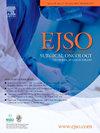罕见胆道腺鳞癌的特征及临床结果
IF 3.5
2区 医学
Q2 ONCOLOGY
引用次数: 0
摘要
背景由于胆汁腺鳞癌(BASC)发病率低,有关它的数据很少。与腺癌相比,胆道腺鳞癌的预后较差,其特殊治疗仍是一项尚未满足的医疗需求。我们对 BASC 进行了描述分析,包括临床病理参数和治疗结果。结果共纳入 16 例 BASC,占所有胆道癌的 1.4%,在过去的 22 年中,BASC 的发病率稳步上升。确诊时的中位年龄为 70.7 岁(最小-最大年龄为 31.4-82.0 岁),大多数患者为女性(62.5%)。确诊时,半数 BASC 患者处于局部分期。原发肿瘤部位为胆囊癌(7 例)和胆管癌(7 例),主要是肝外疾病(71.4%)。中位总生存期为9.5个月(95 % CI = 2.1-14.8个月)。共有 13 名患者(81.6%)接受了手术治疗,无复发生存期中位数为 3.8 个月(95 % CI = 0.0-10.5 个月)。5名患者(38.5%)接受了辅助化疗。共有七名患者(43.8%)因出现转移而接受了化疗,中位无进展生存期为 2.8 个月(95 % CI = 0.8-4.1 个月)。没有观察到客观反应,有两名患者(28.6%)病情稳定。BASC患者预后较差,治疗反应有限。应进一步开展分子研究,探索新的治疗方案。本文章由计算机程序翻译,如有差异,请以英文原文为准。
Characterization and clinical outcomes of rare biliary adenosquamous carcinoma
Background
Data are scarce regarding biliary adenosquamous carcinoma (BASC) due to its low incidence. BASC displays a worse prognosis than adenocarcinoma and its specific treatment is still an unmet medical need. We conducted a description analysis of BASC including clinicopathologic parameters and treatment outcomes.
Methods
All consecutive patients with histologically proven BASC diagnosed in six French hospitals between 2000 and 2022 were enrolled and described.
Results
A total of 16 BASC, accounting for 1.4 % of all biliary tract carcinoma, were included and the BASC incidence increased steadily over the past 22 years. The median age at diagnosis was 70.7 years (min-max 31.4–82.0 years) with most women (62.5 %). At diagnosis, half of BASC patients had a localized stage. The primary tumor locations were shared between gallbladder cancers (n = 7) and cholangiocarcinoma (n = 7), with mainly an extra-hepatic disease (71.4 %). Median overall survival was 9.5 months (95 % CI = 2.1–14.8 months). A total of 13 (81.6 %) patients had undergone surgery with a median relapse-free survival of 3.8 months (95 % CI = 0.0–10.5 months). Five (38.5 %) patients received an adjuvant chemotherapy. A total of seven (43.8 %) patients were treated with chemotherapy for the occurrence of metastases with a median progression-free survival of 2.8 months (95 % CI = 0.8–4.1 months). No objective response was observed and stable disease was achieved in two patients (28.6 %).
Conclusions
BASC is a rare disease with an increased incidence, highlighting the diagnostic challenges. BASC population was associated with a poor prognostic and limited therapeutic response. Further molecular investigations should be performed to investigate new therapeutic options.
求助全文
通过发布文献求助,成功后即可免费获取论文全文。
去求助
来源期刊

Ejso
医学-外科
CiteScore
6.40
自引率
2.60%
发文量
1148
审稿时长
41 days
期刊介绍:
JSO - European Journal of Surgical Oncology ("the Journal of Cancer Surgery") is the Official Journal of the European Society of Surgical Oncology and BASO ~ the Association for Cancer Surgery.
The EJSO aims to advance surgical oncology research and practice through the publication of original research articles, review articles, editorials, debates and correspondence.
 求助内容:
求助内容: 应助结果提醒方式:
应助结果提醒方式:


